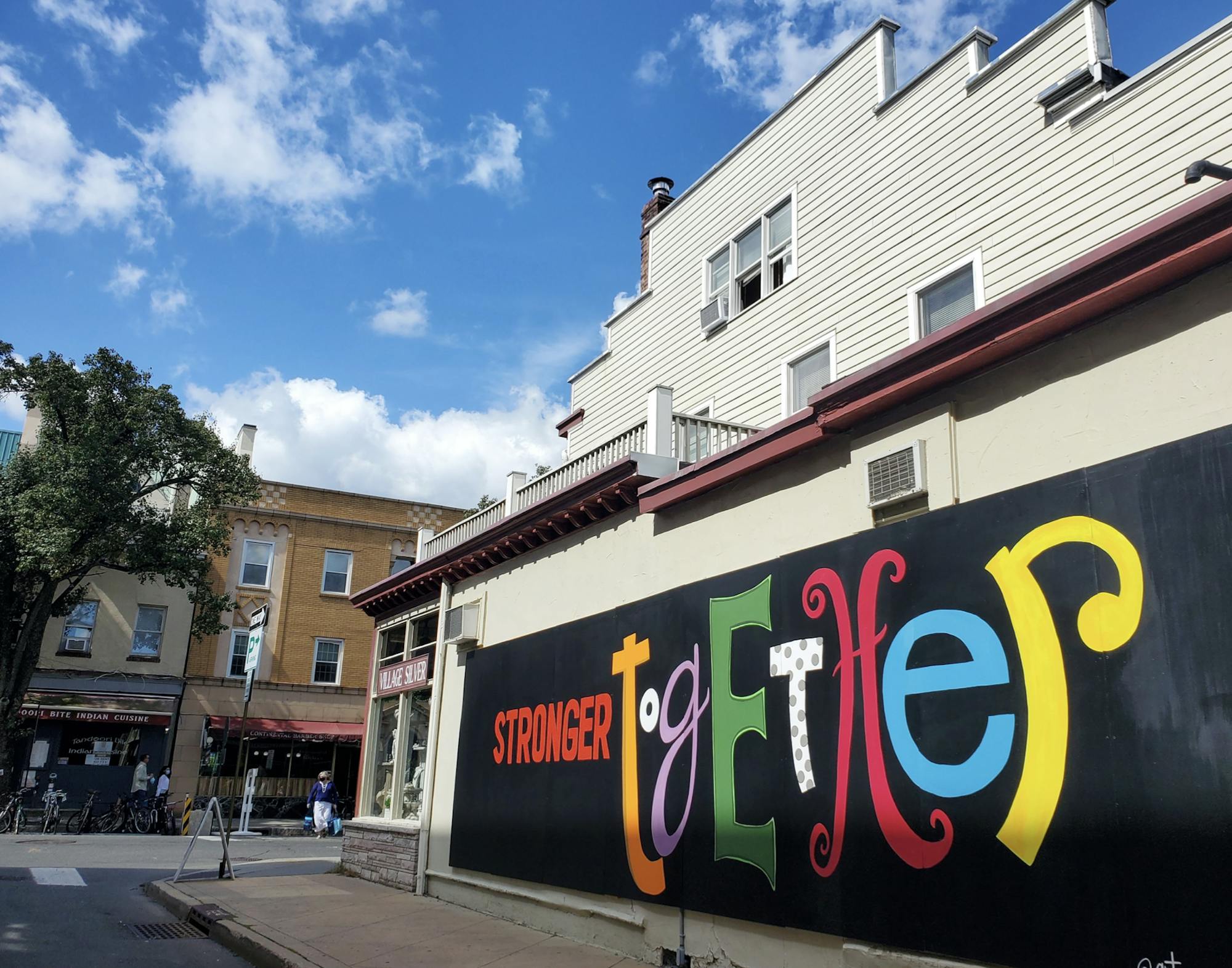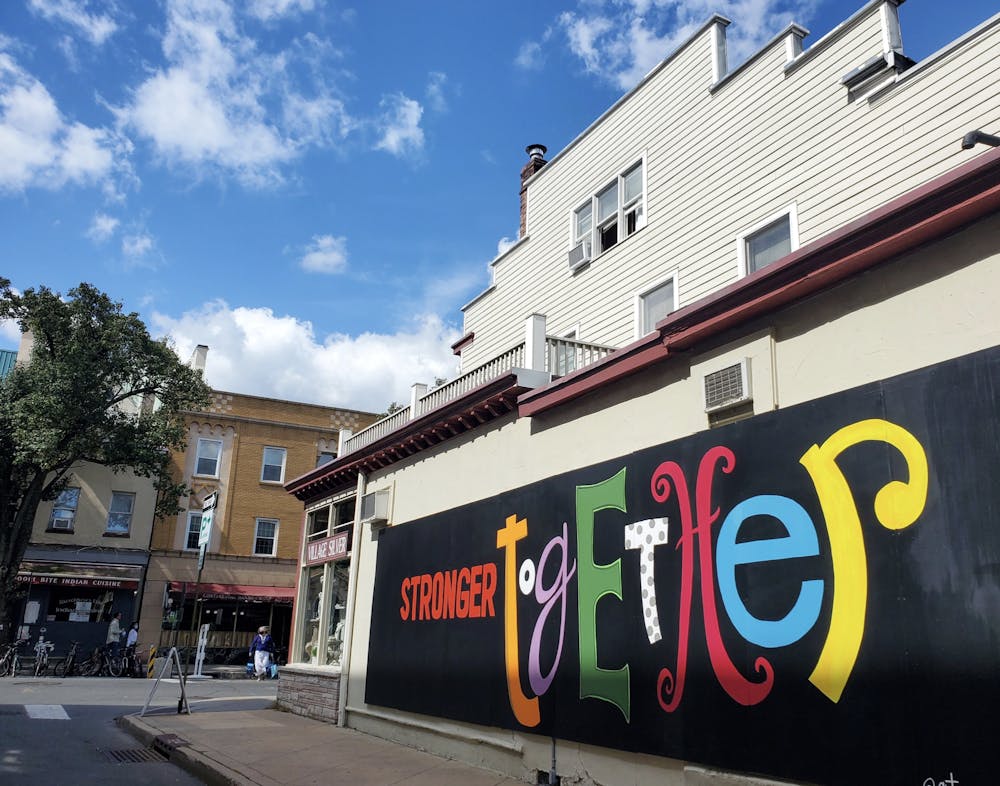Located on the back of the store Village Silver, the once blank wall on Spring Street has become a canvas. The Spring Street Mural, coordinated by the Arts Council of Princeton (ACP), has displayed original art to the town of Princeton since the height of the COVID-19 pandemic lockdown in the summer of 2020. As a part of the ACP’s public art initiative, the blank space was first painted to both promote the community and beautify the area — its first mural was titled “Stronger Together.”

“Stronger Together” was the first mural on Spring Street in July 2020. Its message was intended to uplift the Princeton community during the lockdowns.
Courtesy of the Arts Council of Princeton
The idea for a mural on Spring Street originated with Maria Evans, the Artistic Director for the ACP, and Melissa Kuscin, the Program/Marketing Manager. During the start of the pandemic, Kuscin and Evans were walking around town and noticed that the streets were unusually quiet. They knew that they wanted to utilize art to uplift the community but were not certain of a location until they found a blank wall in the middle of town.
“I saw that wall that is on the side of Village Silver on Spring Street, and I texted a picture to Maria,” Kuscin said. “It was a text between the two of us that was just like, ‘we need to do something.’ That’s where it all started.”
The Spring Street Mural’s rotation of artwork — with a new mural about every three months — sets it apart from other public art sponsored by the ACP. Since the idea was pitched as a rotating mural, artists do not paint their murals directly onto the building, but instead paint on a canvas that was built specifically for the project to facilitate painting new murals over old ones. ACP Executive Director Adam Welch believes that the mural rotation helps residents stay engaged with the artwork.
“When you first see something, you have an experience with it that is outside of the everyday, and it might slowly age and become less impactful,” he said. Therefore, the artwork on the murals is designed to be topical, either featuring messages or pictures that relate to a theme. During election season in 2020, the ACP did “a vote mural, which was a lot of people's favorites, because it was just right in your face, like a sign of the times,” said Kuscin.

The “Vote” mural was completed in September 2020 as last election season was underway.
Courtesy of the Arts Council of Princeton.
Through the artist rotation, the ACP can also support more local artists. In the beginning stages of the project, the first few murals were made by the ACP mural team. Now, the ACP has created an open call on their website for artists to submit mural proposals. They primarily look for submissions from local or tri-state area artists. The ACP aims to provide spaces where local artists can showcase their work, especially since the Princeton area does not have as many galleries as major cities like New York or Philadelphia. “We want to make sure that the artists that are here get as much access as possible to those sorts of opportunities,” Welch said.

Since its first piece in July 2020, there have been ten different murals featured. Currently, “Blooming” by Amilli Onair, a Franco-American artist, is on display. The mural depicts two women with flowers facing each other. Onair’s artwork often features women and flowers, and the idea of two women facing each other is reflective of the Princeton community. “It feels really meant to be that [Princeton] would be the place where the two women were facing each other because I really do feel like within the community, you don’t ever do things by yourself,” she said.
The flowers on the mural are all from places Onair has lived, but she also points out that the variety of florals signify the diversity within the Princeton community. “I like to make things that go beyond the like, ‘Where are you from?’ ‘What do you do?’ It’s like, I’m from all these different places, I can take up all of this space, I can work with all of the people around me that are from different places,” she said.
Onair applied for the mural through the ACP’s open call for artists. While she has painted in both New York and California, community murals are her favorite kind of work. “You can kind of tell that it’s something that the community really appreciates,” she said. After being accepted in mid February, Onair worked on a few iterations of the design then came to Princeton to paint the mural for two days before it was completed.
The Spring Street Mural is just one of the public art projects that the ACP oversees. Since its inception, finding places for public art has become even more important to the ACP in order to increase accessibility. “Public art just demolishes every barrier to entry. It is for the people, by the people,” said Kuscin. Even though the Arts Council building features a curated collection of art, the ACP believes that it is necessary to create art that intersects with community members’ daily lives. They emphasize that art does not need to be understood to be enjoyed.

Welch says that more ACP public art is underway with plans for a mural at the new Avalon Bay apartment complex and a totem pole supported by the National Endowment of the Arts that will be at an indoor location.
Four years since its first iteration, the Spring Street Mural continues to be a Princeton staple, with each new artist helping to uplift the community. Onair sees the impact of her work first hand. While finishing “Blooming” she was approached by a resident who she recalled saying, “I just want to let you know that I just had a really hard day, and I really needed to see this.”
Regina Roberts is an associate editor for The Prospect and contributing staffer for the Podcast section of the ‘Prince.’ She can be reached at rr8156@princeton.edu, or on Instagram @regina_r17.
Please send any corrections to corrections[at]dailyprincetonian.com.








